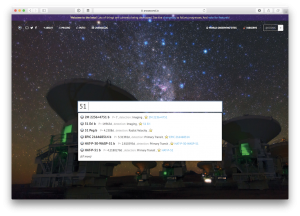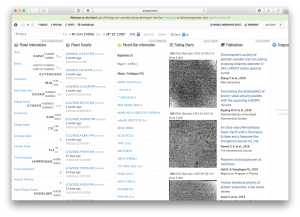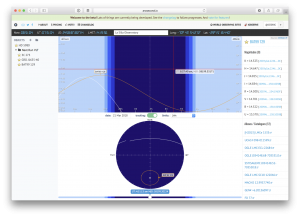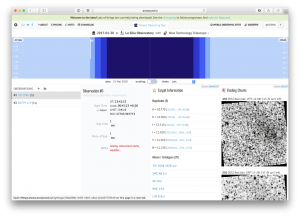Cédric Foellmi (@onekiloparsec) is an astrophysicist and senior software engineer. He is the maker of iObserve: a macOS and iOS app that has been previously featured on Astrobetter. He was also formerly an astronomer at ESO in Chile, where he met Éric Depagne, who was a VLT UVES instrument Fellow and is currently an astronomer at the SAAO/SALT. Éric recently began contributing to the project presented below.
Arcsecond.io is a web app that brings the observing activities of astronomers to the cloud. These activities include observation preparation, night operations, and data management. Arcsecond.io places all of these tools in one integrated place, designed by astronomers, for astronomers. Arcsecond.io is still in beta phase, and some of the features described below aren’t entirely completed. But we’d love to see our developments be driven by your suggestions and comments!
Making iObserve Available on the Web
Arcsecond.io is the home of iObserve on the web! iObserve has been actively developed since 2011 and has been highlighted on Astrobetter several times. It is a macOS app (also available on iOS/iPad) that allows you to prepare observations by making it extremely easy to get a wealth of information with only the name of an object. Given a Simbad-resolvable target name, the app instantly draws airmass curves, star tracks, sky maps, and displays a visibility table. Precise tracking allows observers to follow curves during the night. When relevant, exoplanet transits are overlaid on top of airmass curves. Moreover, magnitudes, catalogs links, publications, nearby standard stars, and finding charts (with a dedicated sky tracking and distance ladder) are one click away. It works with any kind of astronomical object, including exoplanets, asteroids, and comets. Finally, advanced unit converters are easily accessible for coordinates, fluxes, times, and distances.

Screenshot: The automatic exoplanet lookup when searching in the Universe.
The goal of arscecond.io is to make all of the features of iObserve available on the web. A core subset of iObserve is already deployed online. The rest is coming, and will be completed later with additional features not present in the desktop application. For instance, the most important Solar System objects will be available as targets. And we plan to make available a dynamic orrery view for exoplanet systems.

Screenshot: The standard “Object” page for an exoplanet. When relevant, a column labeled “Transits” is also displayed.
The obvious and immediate advantage of a web app is that it is available to everybody (not only Mac users) and everywhere (with no need to go through the AppStore validation process). A web app also removes the need to sync objects between computers. You simply log in to your personal account and all of your data is available to you.
Arcsecond.io is currently in beta, and thus you can freely try iObserve on the web right now! A paid “iObserve” plan will be made available at the end of the beta phase for those who are interested in the best and most sophisticated iObserve web-based tool.

Screenshot: iObserve on the web. Airmass curves are at the top, and star tracks below. Object information is to the right.
New Tools for Observing Runs and Data Management
The features described above for observation planning are only the beginning of the tools that arcsecond.io will be able to provide. Arcsecond.io goes beyond the app with two new major features: Night Operations and Data Management.
The “Night Operations” feature allows you to craft your observing nights and target lists by night and observing run. Detailed observation slots with exposure time (and soon with the addition of overheads), will give you a complete picture of the flow of the night, and the whole run. Moreover, we are currently preparing a tool that will automatically reconstruct the observations you have already done, providing the data are stored inside archives. It will then be easy to browse your entire observing history and look for any associated data or target. You can now try out the Observing Runs and Night Logs, despite these features still being under development. At the end of the beta phase, a separate paid plan will be available for the “Night Operations” feature.

Screenshot: A Night Log (this feature is under construction). Observations will be displayed on top of the night canvas, as well as target curves. Our goal is to make a truly useful observing dashboard here.
The second new area where arcsecond.io goes beyond the desktop app involves data management. Arcsecond.io will offer storage solutions dedicated to FITS files and other data generated in the course of astronomical research. Unlike other data management solutions, arcsecond.io data storage is designed to specifically address the needs of astronomers. First, FITS headers will be automatically indexed and datasets will be easily searchable. Second, the pricing for storage space will be linear with data size. Finally, storage will be split into three different modes to better match data usage: normal, for data which is used regularly and needs to be instantly downloadable; “glacier”, for archives and/or survey data; and “FITS leaks”, to make data freely available. In the much cheaper “glacier” mode, downloads are not instantaneous, but require some minutes of preparation before being available. In both of these two storage options, the uploader remains the owner of their data. The free “FITS leaks” mode (in preparation) will allow astronomers to dump data they no longer want to take care of anymore. Arcsecond.io will store the data, index it, and make it public. In this case, the ownership of the data will be transferred to arcsecond.io, but the uploader will be able to choose whether their name is associated with the dataset or not.
Customization for Research Groups
Finally, we have the ambition to offer services not only to individuals, but also to science groups. For example, we are currently discussing with a French research group about developing a dedicated portal with world live-map for collaborative exoplanet transit follow-ups across the globe.
We are eager to know what you think about every aspect of arcsecond.io. And there will be generous price reductions for active bug reporters and beta testers!
Links:
Follow us on Twitter at @arcsecond_io
https://www.arcsecond.io – The main website, where you can also subscribe to our monthly newsletter
https://api.arcsecond.io – Data sources for the REST/API-savvy astronomers
https://github.com/onekiloparsec/arcsecond-public – The GitHub repository for issues, bug reports, and suggestions.